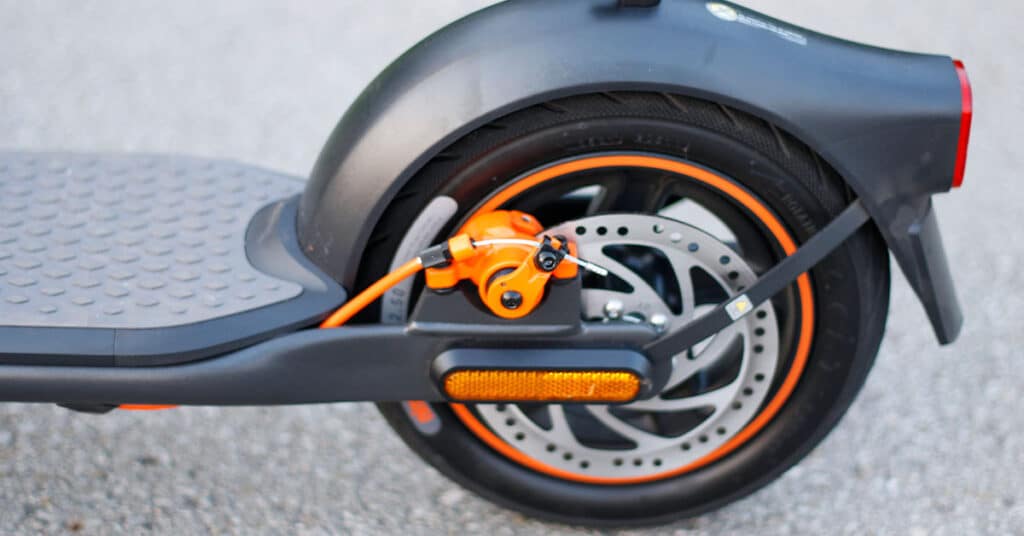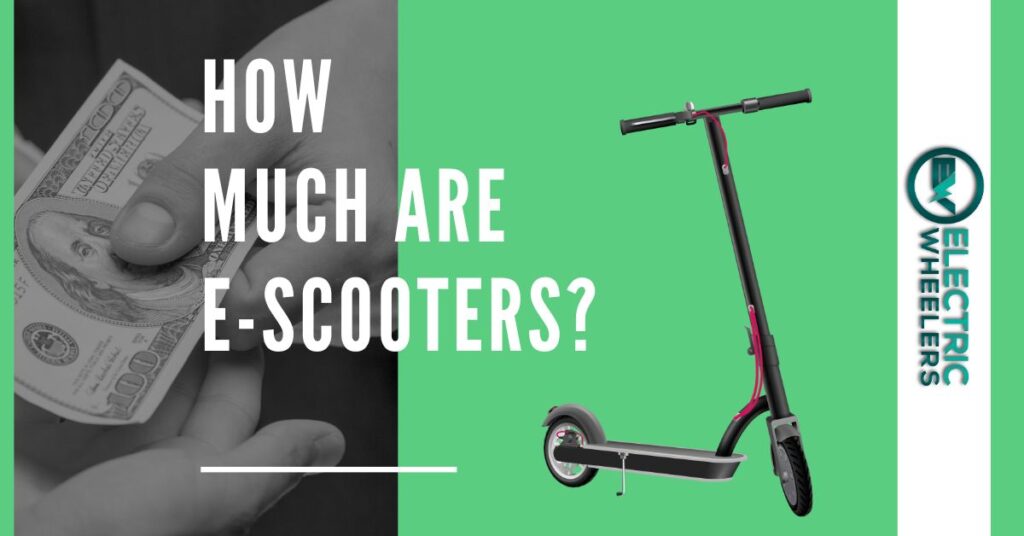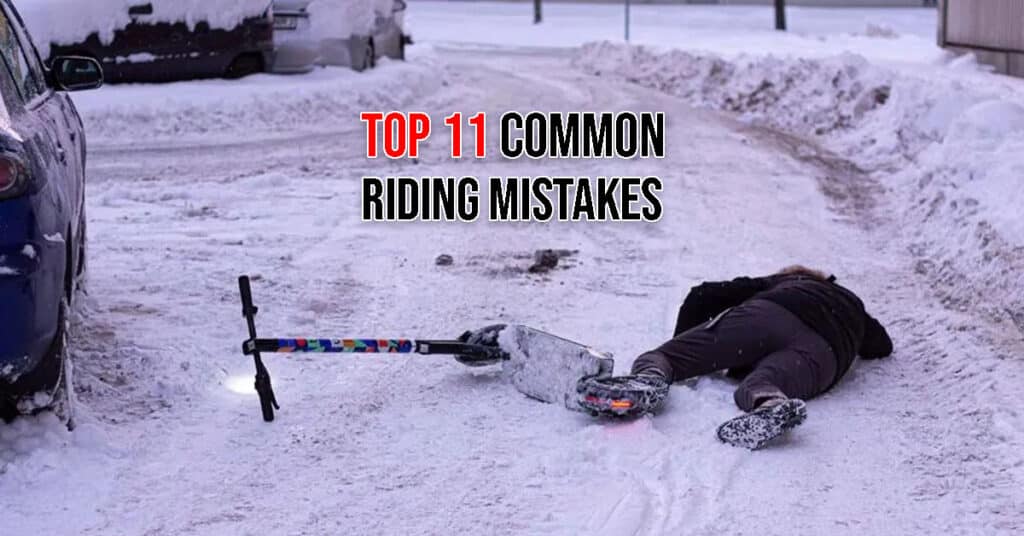Electric scooters have become quite fast, with some going upwards of 20 to 30 mph. However, this could be a huge disaster if manufacturers fit their scooters with inefficient brakes.
A scooter’s (or any other automotive) ability to halt efficiently even when going quite fast is the most important safety aspect.
This article helps inform riders on the best types of electric scooter brakes, how long they last, if you can repair them, etc.
Keep reading to learn some more.
What Type of Brakes are Used on E-Scooters
There are different types of brakes used on electric scooters.
The most common brake types are:
- Disc Brakes
- Mechanical
- Hydraulic
- Semi-Hydraulic
- Drum Brakes
- Electronic Brakes
- Regenerative Braking
- Foot Brake
Each brake type has its advantages and disadvantages. Now, let’s take a closer look at each electric scooter brake type.
Disc Brakes
Manufacturers prefer using disc brakes on their electric scooters since they consider them more efficient than other brakes.
They are thought to be more efficient because of their hand lever-type setup. The hand lever is the most common way to control the brakes, and the setup involves brake calipers, brake pads, and a metal disc (rotor) attached to the scooter’s wheel.
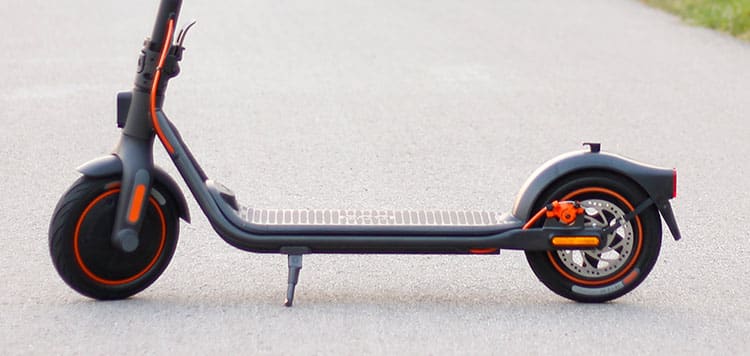
Simply put, disc brakes work like this:
- The rotor spins with the scooter’s wheel.
- The lever grips the scooter’s rotor with a caliper (surrounds part of the rotor).
- Brake calipers activate the brake pads and slow the fast-rolling wheels.
Disc brakes stop the scooter by creating friction, and they come in three types: mechanical, hydraulic, and semi-hydraulic.
Cable-Driven Disc Brakes (Mechanical)
Mechanical disc brakes are the most common brakes on scooters and bikes. They have a simple working mechanism.
Pulling on the lever shortens the cable connected to the brake caliper. Next, the brake caliper transmits the force coming through the cable to the brake pads. These pinch the motor causing friction and bringing the scooter to a halt.
Related: How to Adjust e-Scooter Disc Brakes?
Pros of Mechanical Disc Brakes
- Mechanical disc brakes are cheaper than hydraulic brakes
- They are easier to maintain and repair because of their simplicity
- Easier for users to find replacement parts
- Users can easily service the brakes with basic tools
Cons of Mechanical Disc Brakes
- They are less efficient (provide less stopping power) than hydraulic brakes
- Require more frequent adjustments because the cables stretch
- Trickier for users to modulate the braking force
- They may feel less consistent and smooth due to friction in their brake lines.
- May make a squeaking sound when braking
- Heavier
- Require constant cleaning
- Requires more force to operate
- Considered less technologically advanced
Hydraulic Disc Brakes
Fully hydraulic disc brakes operate using hydraulic lines that activate the scooter’s brake calipers.
Squeezing down on the brake lever increases pressure in the hydraulic lines. The lines are connected to the scooter’s brake calipers, and increasing pressure in the lever pushes against pistons that move and pinch the rotor.
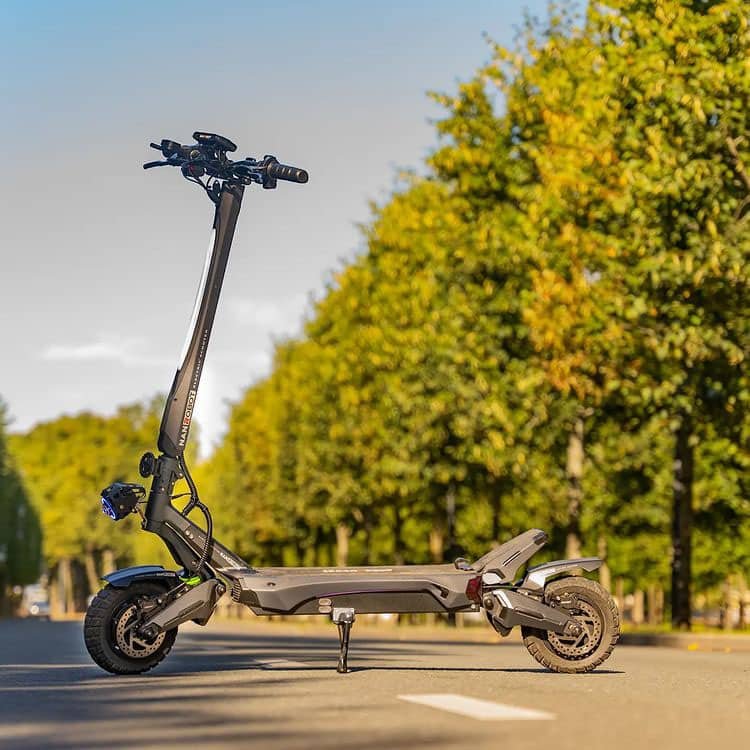
These are the best disc brakes since their hydraulic function gives you more control over your braking. Braking with hydraulic disc brakes is consistent, strong, and easy.
The feeling contrasts with mechanical disc brakes (cable-activated), which don’t feel consistent or linear due to the cables’ friction.
Pros of Hydraulic Disc Brakes
- More efficient than other brakes
- Best stopping power
- Less frequent maintenance (the brakes self-adjust)
- Less cleaning since the system is sealed, keeping contaminants out
- Smoother operation due to minimal friction in the system
- Lighter
- Easier on the hands
- More consistent
- Better control over the braking force
- Shorter stopping distances
- High-end
- Almost silent when braking
Cons of Hydraulic Disc Brakes
- More costly than other brakes
- Difficult to maintain since you have to bleed the brake lines periodically
- Harder to find spare parts
- Harder to service (require specialized tools and fluid)
Semi-Hydraulic Disc Brakes
Semi-Hydraulic (or hybrid hydraulic) brakes are similar to hydraulic brakes; however, they have a cable that runs from the system’s lever to the caliper instead of a hydraulic line.
The cable-actuated hydraulic brakes are much less common than other types of disc brakes.
When users pull the lever, the cable activates the caliper that moves a hydraulic piston, providing stopping power. These types of braking systems provide a fairly consistent and strong stopping power.

Pros of Semi-Hydraulic Disc Brakes
- Are easy to repair than fully hydraulic brakes
- Are more efficient than mechanical brakes
- Have fairly consistent braking
Cons of Semi-Hydraulic Disc Brakes
- Less efficient than fully hydraulic brakes
- There will be a cable drag
- More lever pulling is needed for same braking force as hydraulic brakes
Drum Brakes
Drum brakes are enclosed in the wheel hub. They are activated by hand levers (cable-actuated).
When activated, the pads of the drum brakes push out against the braking surface, creating friction. They are fully closed, protecting them from the environment.

The brakes create a lot of heat when activated, making them less effective, especially during moments of continuous activation.
The issue may not be much of a problem for scooters as it is for cars; however, it may affect the drum brake’s performance.
Drum brakes are effective (almost as well as disc brakes) and require less maintenance. However, they are more complex to work on.
Related: How to Adjust E-Scooter Drum Brakes
Pros of Drum Brakes
- Low maintenance
- Moderate braking performance
- Great performance in wet conditions
- Completely enclosed
Cons of Drum Brakes
- They are heavier
- Complicated to repair and disassemble
- Lower performance when overheated
- Poorer performance than disc brakes
Electronic Brakes
The electronic brake only acts as an auxiliary brake and cannot be the primary method of stopping.
When the electronic brake is activated, then the power of the motor is cut out. When the motor loses momentum, it will develop friction, which makes the scooter stop eventually.
Riders can activate the brakes using brake levers or a push button.
Some scooters have a push button on their handlebars that engage the brakes when braking. The switch shorts the motor’s terminals creating resistance during motor rotation.
Other models require users to slightly pull and release brake levers to activate the brakes. Riders will feel the scooters slowly decelerate as the scooter’s electronic brakes engage.
Electronic brakes work in a similar way to regenerative brakes. The primary difference is they don’t recharge the battery.
Pros of Electronic Brakes
- No maintenance or added weight
Cons of Electronic Brakes
- Poor implementation of braking systems making the brakes prone to failure
- Poor braking performance
Regenerative Braking
Riders activate regenerative brakes by activating a switch that electrically couples the scooter’s motor into the charging system.
This creates resistance to the motor’s rotation, slowing down the bike. The idea for this motor is to recover energy when braking to increase the scooter’s range.
Some manufacturers design their scooters to activate regen when riders let go of the throttle. Other manufacturers design their scooters’ regen through a dedicated button or a brake lever.
However, most scooters have other braking systems used in conjunction with the regenerative braking system.
Theoretically, regenerative brakes work; however, they aren’t as good as mechanical or hydraulic brakes and marginally improve the scooter’s distance.
Most e-scooter companies overestimate how much additional range riders can get from regenerative brakes. We noted that the brakes don’t help much to extend a scooter’s range.
Pros of Regenerative Braking
- Minor energy recovery
- No maintenance or added weight
Cons of Regenerative Braking
- It may not be effective when the battery is fully charged
- Poor braking performance
- Some of the systems are prone to failure due to poor implementation
Foot Brake
Foot brakes consist of a hinged fender that riders push down on a scooter’s rear tire to stop. The foot brake generates friction and slows down the wheel. Riders activate the foot brake by pushing down on the rear fender with their heel.
Thus, riders must place their foot towards the scooter’s rear ready to press the foot brake down whenever they want to stop.
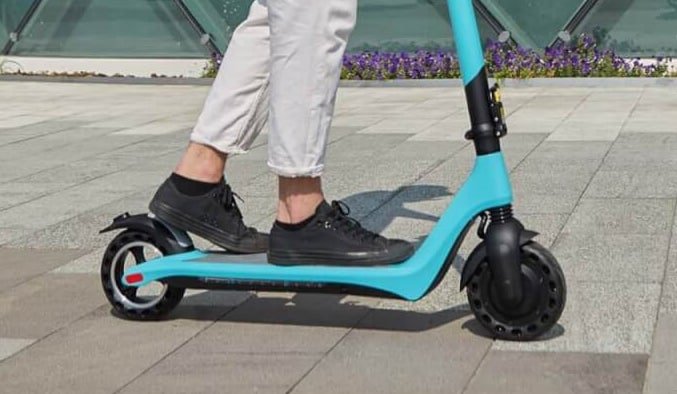
This may sound simple; however, the slight movements can cause some riders to lose balance, especially when riding scooters with small tires. This is a mistake you don’t want to make when braking.
Pros of Foot Brake
- Lightweight braking system
- No maintenance
- Simple design that’s easy to use
Cons of Foot Brake
- Not as effective as brakes activated by hand
- Poor performance
- Bad performance in wet conditions
- Requires uncomfortable riding positions
Dual Brakes vs Single Brake
You should understand your scooter’s braking system since it’s essential for your safety. In addition, you should purchase an electric scooter with dual brakes for redundancy.
If your scooter’s front brakes may fail, it will help if it has a rear braking system.
Additionally, dual braking systems are great for poor road conditions, like wet roads with slippery surfaces. The dual brakes will help you stop quicker than if your scooter had a single brake.
Read Also: Electric Scooter Motors Explained
You should ensure that your bike has different types of brakes. One should be effective, especially the rear brake, while the other is durable, dependable, and can be easily fixed.
Cheap electric scooters often have just a single brake to keep the scooter’s price down. Often the single brake is combined with an electronic brake. It will slightly improve the stopping power.
However, all high-end electric scooters have a dual braking system (usually mechanical or hydraulic disc brakes).
What Type of Brakes is Best for an Electric Scooter?
Generally, hydraulic disc brakes are considered the best brake type for electric scooters.
An electric scooter with disc brakes is perfect for wet and dry conditions. The brakes are reliable, easy to adjust, and lightweight.
Most high-performance electric scooters have hydraulic disc brakes.
However, some riders prefer a scooter with drum brakes because they are less likely to get damaged. Additionally, the brakes require less maintenance and the scooter itself is cheaper.
They provide poorer braking performance than disc brakes and have longer stopping distances, but it’s okay if the speed of the scooter is reasonable.
Electric Scooter Brakes FAQs
Do Electric Scooters Have an ABS (Anti-Lock Braking System)?
ABS prevents wheels from locking up in case of emergency braking. Scooters with ABS have a sensor ring close to the brake disc. The ring detects movement, overrides the system, and interferes with regaining grip whenever the wheels lock up.
Riders can experience this as a pulsing feeling through their lever. Latest regulations mandate that all motorcycles and scooters have CBS (Combined Braking System) or ABS to increase the rider’s safety in case of road conditions or a mistake. The system helps keep the scooter upright, reduces braking distance, and minimizes impact on speed.
Do Electric Scooters Have a Regenerative Braking?
Some electric scooters have regenerative braking.
Regenerative braking converts kinetic energy and stores it in a scooter’s battery during deceleration.
Do E-Scooter Brakes Require a Maintenance?
You should check your brakes regularly, especially for individuals using disc brakes.
The brake pads may wear down after continuous use and must be replaced. Additionally, the discs may require you to adjust them over time.
How Long Do Electric Scooter Brakes Last?
Electric scooter brakes last between 200-600 miles, depending on how and how often you use the scooter.
Various factors affect the braking pads and braking system’s condition. You should check the brakes regularly for damage and repair them when necessary.
Related: How Long Do Electric Scooters Last?
How to Prolong Electric Scooter Brakes?
It would help if you were careful when braking and ensured you service your scooter regularly.
Additionally, you should ensure you purchase good-quality brake parts if you want them to last long.
Can You Repair Electric Scooter Brakes By Yourself?
You can repair electric scooter brakes by yourself if you know how to. However, the best option would be to take them to an experienced repair person for professional repair services.
Repairing the brakes alone can lead to various problems with the braking system. You could damage the brakes badly enough that you’ll need a complete replacement or get into a serious accident that may harm you.
However, everyone can do some simpler brake adjustments.
A freelance writer and copywriter.

